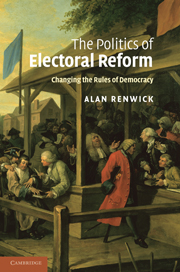Book contents
- Frontmatter
- Contents
- List of tables
- List of figures
- List of abbreviations
- Acknowledgements
- 1 Introduction
- PART I Building blocks
- 2 What motivates actors?
- 3 From motivations to outcomes: exogenous factors
- 4 The reform process: endogenous factors
- PART II Elite majority imposition
- PART III Elite–mass interaction
- Appendix: glossary of electoral system terminology
- Bibliography
- Index
4 - The reform process: endogenous factors
Published online by Cambridge University Press: 04 May 2010
- Frontmatter
- Contents
- List of tables
- List of figures
- List of abbreviations
- Acknowledgements
- 1 Introduction
- PART I Building blocks
- 2 What motivates actors?
- 3 From motivations to outcomes: exogenous factors
- 4 The reform process: endogenous factors
- PART II Elite majority imposition
- PART III Elite–mass interaction
- Appendix: glossary of electoral system terminology
- Bibliography
- Index
Summary
I have so far treated the factors that shape the process of electoral reform as exogenous: either as fixed or as changing only in response to factors outside the process itself. Yet those factors are often, at least to some degree, amenable to change from within the reform process. Two mechanisms of such endogenous change may particularly be noted. The first stems from the intentional action of participants within the process, through exercise of leadership, the second from the unintended consequences of action, notably through path dependence.
In this final chapter on the building blocks of electoral reform, I analyse in turn these two endogenous factors. I look at the possible strategies of actors who wish to steer the reform process, and at ways in which the process itself takes over and subverts the intentions of its human participants. Unlike in the previous chapter, I do not seek to identify the antecedent conditions of these various mechanisms: by their nature, their incidence is generally unpredictable. Rather, I catalogue the mechanisms in order to give a clear framework for the analysis in Parts II and III.
Leadership
Leadership is a concept that has proved very difficult to pin down, even though everyone knows it exists out there. Bennis and Nanus (1985: 4) claim to find 350 definitions of the term. As I shall use the term here, leadership occurs where actors change how other actors behave, and they do so in intended ways.
- Type
- Chapter
- Information
- The Politics of Electoral ReformChanging the Rules of Democracy, pp. 69 - 86Publisher: Cambridge University PressPrint publication year: 2010



